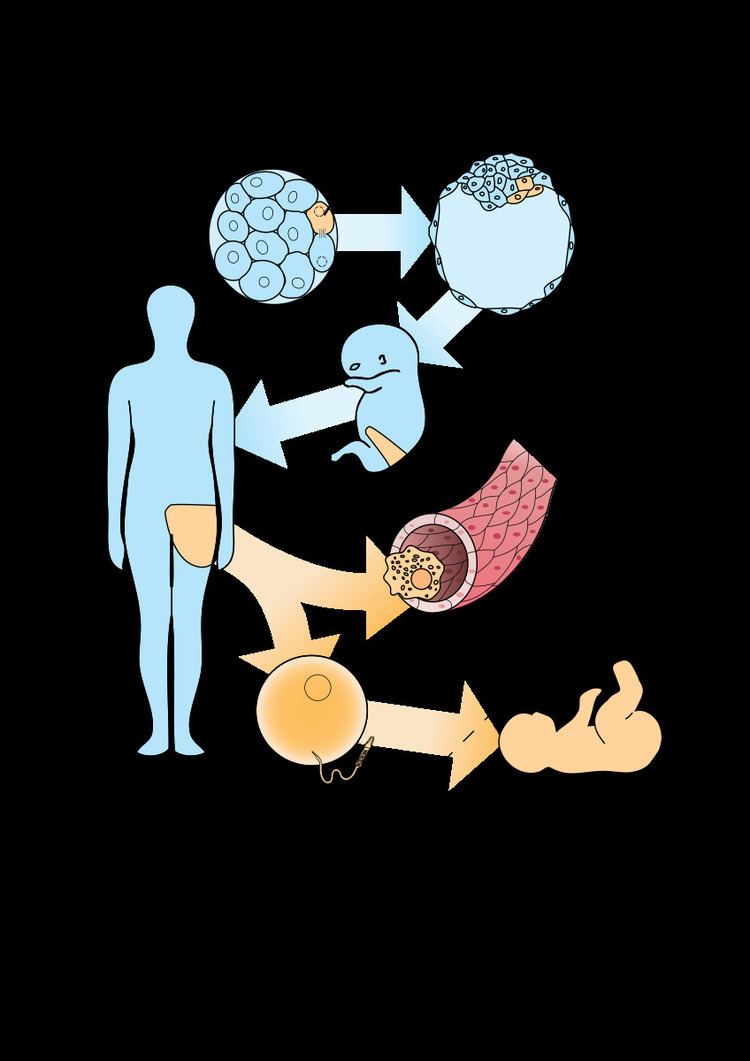 | ||
A post- zygotic mutation is a change in an organism's genome that is acquired during its lifespan, instead of being inherited from its parent(s) through fusion of two haploid gametes. Mutations that occur after the zygote has formed can be caused by a variety of sources that fall under two classes: spontaneous mutations and induced mutations. How detrimental a mutation is to an organism is dependent on what the mutation is, where it occurred in the genome and when it occurred.
Contents
Causes
Post- zygotic changes to a genome can be caused by small mutations that affect a single base pair, or large mutations that affect entire chromosomes and are divided into two classes, spontaneous mutations and induced mutations.
Spontaneous Mutations
Most spontaneous mutations are the result of naturally occurring lesions to DNA and errors during in DNA replication without direct exposure to an agent. A few common spontaneous mutations are:
Induced Mutations
Induced mutations are any lesions in DNA caused by an agent or mutagen. Mutagens often demonstrate mutational specificity, meaning they cause predictable changes in the DNA sequence. A few common mutagens that induce mutations are:
Consequences
A large determinant of the severity of consequences caused by post- zygotic mutations is when and where they occur. As a result consequences can range from being negligible to incredibly detrimental.
Mosaicism
When an individual has inherited an abnormality it is usually present in all of their cells. However some mutations like DNA code change, epigenetic alterations and chromosomal abnormalities, can occur later in development. This would result in one progeny cell line to be normal while the other cell line(s) to be abnormal. As a result the individual is considered to be a mosaic of normal and abnormal cells.
Mosaicism is the occurrence of two or more cell lines with different genotypes within a single individual. It is different from chimerism which is the fusion of two zygotes, causing a new single zygote with two genotypes.
Trisomy 21 Mosaicism
Trisomy 21 (Down Syndrome) is one of the most prevalent chromosomal abnormalities amongst live births. Of all trisomy 21 pregnancies, approximately 80% end in spontaneous abortions or still-births. 1-5% of people diagnosed with having Down Syndrome are actually in fact "high- grade" trisomy 21 mosaics. The rest of trisomy 21 mosaics are marked as "low- grade" mosaics, meaning the chromosomal mutation occurs in less than 3-5% of respective tissue. While high- grade trisomy 21 mosaics, demonstrate similar features to full Down Syndrome, low- grade mosaics have a tendency to show milder features, however the effects are quite variable depending on the distribution of the trisomic cells.
Somatic mutations
Somatic mutations are the result of a change in the genetic structure after fertilization. This type of mutation also involves cells outside of the reproductive group and thus is not transmitted to future descendants.
Germ- line mutations
Germ- line mutations are the result of a change in the genetic structure of germ cells. These mutations are able to be transmitted to the offspring and give rise to a constitutional mutation. Constitutional mutations is a mutation that when present in one cell, is also present in all other cells associated with the organism.
